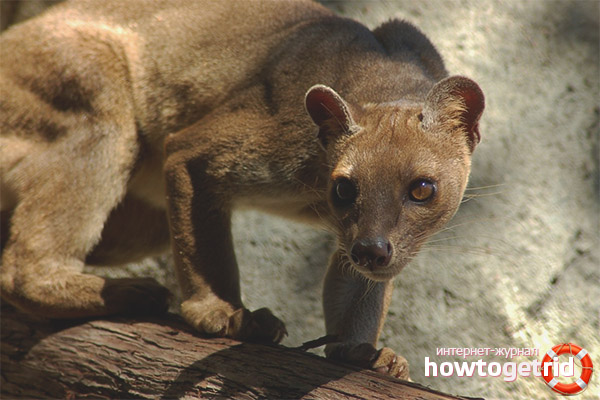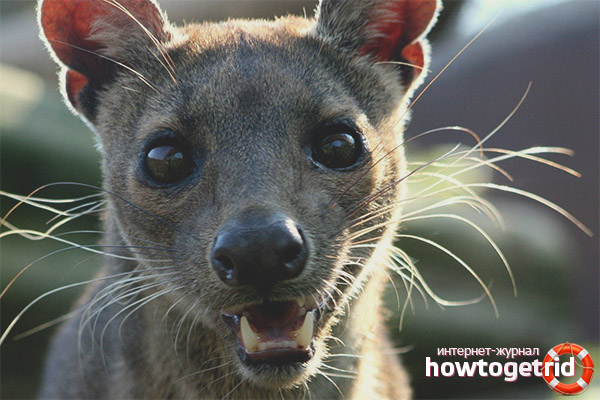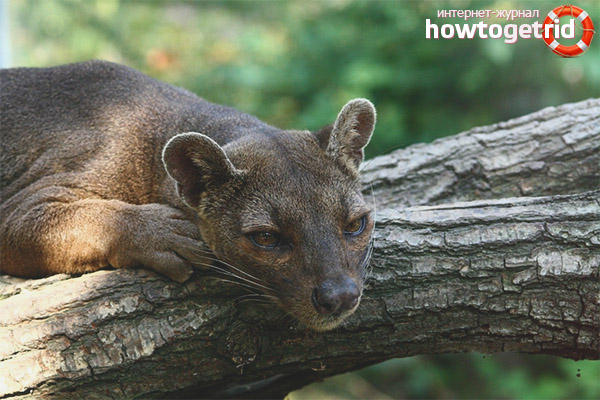The content of the article
By fossa is meant a large-sized animal living in Madagascar. Of the animal population there, this wild animal is considered the largest. It prefers to hunt lemurs, expertly climbs trees and is distinguished by other interesting habits. This material is devoted to Foss, its main characteristics and lifestyle. We will analyze the main criteria in order, so that you can make your own opinion.
Habitat and features
- The individuals of this species definitely have external similarities with representatives of the cat family. The inhabitants of Madagascar even called the fossa a wild lion. But, despite all this, the mongoose is a hypothetical relative, according to scientists. Residents exterminated wild individuals even when they had just begun to populate the island part.
- Fossa fell out of favor for one simple reason. Individuals of this family hunted livestock, thereby damaging livestock. Some wild representatives of the species often attacked people, so they began to be massively exterminated. Modern inhabitants of the island were later allocated a separate family. They are ranked as Madagascar wyverns creatures.
- Many people are surprised by the external characteristics and habits of this animal. According to the overall characteristics of the body, they are stretched to 80 cm. These are indicators with the exception of the tail. The muzzle is shortened and cut. The ears are large and rounded in format, the mustache is elongated. The color is variegated and varied, it all depends on the individual. Often found exactly foss pigmented in a brown tone. Black animals are even less common.
- Regardless of pigmentation, all predators have a powerful body structure. They are muscular. Paws shortened, but strong, with long and sharp claws. They are put forward during the attack, allowing you to make a clear blow and leave lacerations. The articulated parts on the paws are movable, which helps the creatures to climb trees and also deftly descend from them. Foss are so dexterous that they go down the trunk head down, ordinary cats can not so boldly wield their torso.
- The tail acts as a kind of balancer. It helps individuals maintain balance while running, descending, or moving through trees. Locals claim that none of the animals presented has ever been trapped by the fact that he can not go down the tree. Predators do this very well without outside help. These animals leave behind an unpleasant odor similar to that of skunks. Agility animals are comparable to proteins.
- Scientists researching individuals have discovered special stink glands in them. Some are even sure that the smell not only scares off, but also kills the stranger. Predators do not live in the central part of Madagascar, but hunt throughout the island. They choose savannas, fields, forest areas, less often mountains for habitation.
Nutrition
- Most of the daily diet is made up of lemurs. But many know this, just watch the cartoon "Madagascar." The menu also includes mice, chickens, rats, pigeons. Foss can eat lizards, birds.
- Locals do not like these predators, because they attack chicken coops. They steal eggs and chicks, they can drive and kill adult birds. Also, animals need water, which they find near agricultural land.
Lifestyle
- An interesting fact remains that the individuals in question lead a lifestyle like owls. In the daytime, the fosses fall asleep. At dusk, such animals go hunting. Such predators move beautifully through the trees.They easily jump from branch to branch.
- Represented individuals use dug holes, caves, and even abandoned termite mounds as shelters. As for the characteristic features, the Foss prefer to lead a solitary lifestyle. Such animals do not form groups and they do not need a company. On the contrary, each individual tries to allocate a separate territory.
- Individual strong males can capture an area of up to 20 km. Further, the predator marks its possessions with a specific and very strong smell. In addition, the animals in question have a cat's voice. Young animals can even purr cute. Adult fossians growl, hiss and meow.
Breeding
- It is worth noting that the animals in question are found among themselves only in the mating season. Therefore, even loners have a brood. Most often, in such animals, the mating season begins in mid-autumn. It is at such a time that males begin to chase females. In this case, up to 4 males can fight for the female.
- Representatives of the stronger sex are constantly fighting among themselves and strongly bite each other. At this time, the female climbs the tree and waits for the winner. After all the battles, the male climbs to the female. In this case, individuals can continue to mate for up to 1 week. In addition, they replace partners.
- And after a week the female gets down from the tree and another rises in her place. The process of winning her attention resumes. Only the female is engaged in the cultivation and education of young animals. After 3 months, up to 5 cubs are born. They are completely helpless and weigh only about 100 grams. everyone.
- After about a couple of months, the youngsters are already learning to climb trees and jump from branch to branch. At the age of four months, the kids already begin to hunt on their own. As early as 1.5 years, the cubs leave their mother and begin to live a completely independent life.
- However, they become fully grown by about 4 years. At this age, animals are already able to start a family. An interesting fact is that the considered individuals in captivity are able to live up to 20 years. As for wild conditions, it is impossible to calculate.
- The main predator and adversary of such animals is precisely man. Local residents in Madagascar are constantly exterminating foss. People consider them pests. However, such animals are often hunted by snakes and birds of prey. Often even crocodiles attack the foss.
- In addition, the considered animals have been listed in the Red Book for a long time. Such individuals are on the verge of extinction. Their appearance is rapidly declining every year. Already in 2000, foss was recognized as an endangered species. At that time, the number of animals on the whole earth did not exceed 2.5 thousand.
- At the same time, specialists took up a special program to restore the species and reproduce individuals in captivity. In just 8 years, the status in the Red Book has changed to protected and vulnerable. If everything continues in the same direction, people will be able to maintain this unusual and amazing view of the animal world.
As you already understood, foss are amazing and quite rare animals. Such predators are protected. Unfortunately, the presented individuals may disappear altogether. The authorities are making tremendous efforts to maintain this species on earth. Currently, the situation remains more or less stable. However, the Vosses are still vulnerable.
Video: Fossa (Cryptoprocta ferox)












Submit